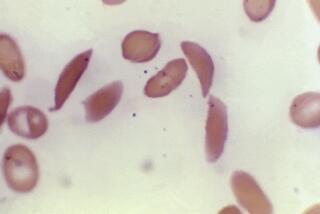Study Details Success of First Gene Therapy
- Share via
WASHINGTON — Two girls who were the first patients in history to undergo gene therapy are now thriving and living near-normal lives, despite being born with a usually lethal immune disorder.
Doctors from the National Institutes of Health said that since the therapy started in 1990, both girls have developed strong immune systems, including copies of the genes that were transferred into their bodies to replace genes they were born without.
The doctors’ report is being published today in the journal Science.
The two patients were born with a condition called severe combined immunodeficiency disease. Houston’s famed “bubble boy” had a form of the disease.
Patients with this disorder lack the immune system cells required to protect against infection. Such patients often become sick from germs that are controlled routinely in people with normal immune systems. Most die at an early age.
Doctors determined that the girls’ disorder resulted from flawed genes that failed to produce adenosine deaminase, or ADA, an enzyme essential for the proper number of disease-fighting white blood cells.
The girls, then ages 4 and 9, were brought to the NIH, where researchers received permission to use them as subjects in a pioneering gene therapy program.
Gene therapy started in September, 1990, for one patient and in January, 1991, for the other.
Doctors took white cells, or T-cells, from the blood of the patients and cultured the cells until they multiplied to many thousands. The researchers then mixed the cells with a virus that was altered to include the normal ADA gene but rendered harmless. When the virus infected the T-cells, it also transferred the ADA gene into them.
Researchers then injected the altered T-cells into their young patients.
In the study in Science, the researchers report that both patients have exhibited evidence that the ADA gene has been incorporated into their immune systems. One patient now has a normal level of T-cells and leads a near-normal childhood. The second patient was somewhat less responsive, but the report says she has a stronger immune system and no longer suffers from chronic sinus infections.






